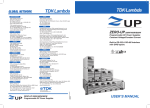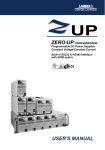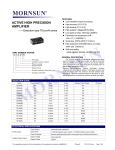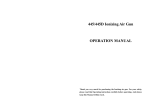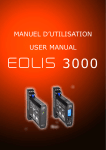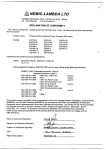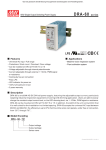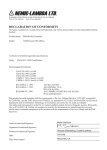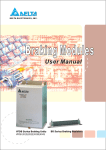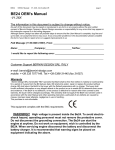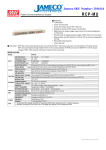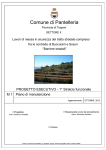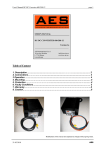Download Untitled
Transcript
NEMIC-LAMBDA SWS 600 INSTRUCTION MANUAL 1. Front Panel Explanation SWS600 Panel (1) V.ADJ : Output voltage adjustment trimmer (The output voltage rises when trimmer is turned clockwise.) (2) ON : Output (Power On) indication LED (The indicator turns on when the power supply output is in normal operating condition.) (3) + : + Output terminal (M4 screw x 3) (4) - : - Output terminal (M4 screw x 3) (5) +S : Remote sensing terminal for + output (for remote sensing function which compensates for line drop between power supply terminals and load terminals.) (6) -S : Remote sensing terminal for - output (for remote sensing function which compensates for line drop between power supply terminals and load terminals.) (7) PC : Current balance terminal (for current balancing in parallel operation.) (8) TOG : Ground for CNT and PF signal (9) CNT : ON/OFF control terminal (for power supply output on and off control with an external signal.) (10) PF : Power fail signal output terminal. (As the output voltage drops, “Power Fail” terminal will output “High”.) (11) : Safety Earth (Frame ground) (12) AC input terminal N : Neutral line (13) AC input terminal L : Live Line (Fuse in line) 1 NEMIC-LAMBDA SWS 600 INSTRUCTION MANUAL 2. Terminal Connection Method l Remote sensing lines shall be twisted or use shielded wire. l Remote ON/OFF control lines shall be twisted or use shielded wire. l Output current of each terminal pin must be less than 40A. l Input must be off when making connection. l Connect terminal to ground terminal of the equipment. l The output load line and input line shall be separated and twisted to improve noise sensitivity. SWS600 Panel Side n Basic connection (Local sensing) n Remote sensing required Connect “+S” terminal to “+” terminal and “-S” terminal to “-” terminal with short piece. (Mounted on terminal strip at time of shipment.) Remove the two short pieces between “+/-S” to “+/-” terminals from terminal strip. Connect “+S” terminal to “+” terminal of load and “-S” terminal to “-” output terminal of load with wires. When remote sensing terminal are opened, output is shut down. n ON/OFF control required n PF signal output required Use the circuit shown below. “TOG” terminal is Ground for CNT. Open collector method shown below shall be used. “TOG” terminal is ground for “PF” terminal. 2 NEMIC-LAMBDA SWS 600 INSTRUCTION MANUAL 3. Functions and Precautions 3-1. Input Voltage Range automatically recovered when the overload condition is cancelled. Do not operate overload or dead short conditions for more than 30 seconds, which could result in damage or insulation failure. Input voltage range is single phase 85~265VAC (47~63Hz) or 120~330VDC. Input voltage which is out of specification may cause unit damage. For cases where conformance to various safety specs (UL,CSA,EN) are required, input voltage range will be 100 ~ 240VAC ( 50/60Hz ). Maximum output power is derated linearly if input voltage is less than 115Vac. 3-5. Over Temperature Protection (OTP) Over temperature protection function is provided. When ambient or internal temperature rises abnormally, OTP will shut down the output. After shut down, first remove the input and cool it down before re-input. Output derating vs Input voltage. 3-6. Low Output Detection Circuit Low output detection circuit is provided. PF signal will turn “High” level to indicate the abnormal status when the output voltage is below 80% of rated value caused by either the drop or brown out of the input voltage or OCP, OVP and OTP function operation. The PF signal is insulated by a photo coupler. It uses the open collector method shown as below. SWS600-24, 48V SWS600-5V 3-2. Output Voltage Range V.ADJ trimmer on the front panel is for output voltage adjustment within the range of specifications. To turn the trimmer clockwise, the output voltage will be increased. Note over voltage protection (OVP) function may trigger if the output voltage is increased excessively. PF VCE max=30V IC max=20mA TOG 3-3. Over Voltage Protection (OVP) 3-7. Remote Sensing (+S, -S terminal) The OVP function (Inverter shut down method, manual reset type) is provided. When OVP triggers, the output will be shut down. The input shall be removed for a few minutes, and then re-input for recovery of the output. OVP setting is fixed and not to be adjusted externally. This function compensates voltage drop of wiring from output terminals to load terminals. Connect “+S” terminal to “+” terminal of load and “-S” terminal to “-” terminal of load with sensing wires. The total line voltage drop (+ side line and - side line) shall be less than 0.3V. In case that sensing line is too long, it is necessary to put an electrolytic capacitor in following 3 places. 1) Across the load terminal, 2) Between “+S” terminal and “+” terminal, 3) Between “-S” terminal and “-” terminal. 3-4. Over Current Protection (OCP) Constant current limiting, automatic recovery. OCP function operates when the output current exceeds OCP specifications. The output will be 3 NEMIC-LAMBDA SWS 600 INSTRUCTION MANUAL 3-9. Output Ripple & Noise If remote sensing terminals are opened, the output will rise and OVP be triggered. Ripple & noise are measured at 20MHz by using a 12’’twisted pair terminated with a 0.1uF& 47uF capacitor. When Load lines are longer, ripple becomes larger. In this case, electrolytic capacitor, film capacitor, etc. might be necessary to use across the load terminal. The output ripple cannot be measured accurately if the probe ground lead of oscilloscope is too long. +S + + + Power Supply + -S Load - 3-10. Parallel Operation + Current balancing function is provided. Either of operations mode (A) or (B) is possible. To attach PC to PC terminal and -S to -S terminal, the current balancing function activates and output current of each power supply is equivalently supplied to load. Wires to PC terminals shall be as short as possible and same length. 3-8. Remote ON/OFF Control Remote ON/OFF control is available. Using this function, output on/off is allowed to control without input voltage on/off. It is controlled by the voltage applied to CNT and TOG. This circuit is in the secondary (output) side of the power supply unit. Do not connect in the primary (input) side. And this circuit is isolated from the output by a photo-coupler. Power Supply (A) To Increase the Output Current 1. 2. Relay, Transistor, TTL etc. CNT 3. 1kΩ TB51 R E 4. TOG Adjust the output voltage of each power supply to be same value within 1% or 100mV, whichever smaller. Use same length and type of wires for all load lines. Please use with output current less than 80% of rated output current for all paralleled power supply units. Parallel operation possible until 5 units. All paralleled units shall be same type of power supply. Control mode is shown below. Power Supply CNT Level for TOG Terminal Lower than 0.8V ON Higher than 4.5V OFF External Voltage Level :E +S Output Condition Load External Resistor :R 4.5~12.5VDC Not required 12.5~24.5VDC 1.5k Ω PC -S PC +S -S 4 NEMIC-LAMBDA SWS 600 INSTRUCTION MANUAL 3-12. Remote Programming (B) To Use as a Backup Power Supply 1. Adjust the output voltage of each power Connecting a remote programming resistor such as a potentiometer between “+S” and “+” terminal, remote programming becomes possible to use. The rate of the change due to the remote programming resistor is 1.25V/kΩ. Please refer to customer specifications for output range. supply to be same value. Set power supply output voltage higher by the forward voltage drop of diode. Use within the specifications for output voltage and output current. 2. 3. Power Supply +S +S + + -S - V.ADJ AC Vo+Vf Vo SWS AC Output Power(W)=(Vo+Vf)×Io Vf Io Load Set at lowest setting Load 3-13. Peak Output Current -S Vf For SWS600-5V, the relation between peak output current and average output current is defined as below: +S Vo+Vf Ip -S Im 3-11. Series Operation 0A For series operation, either method (A) or (B) is possible. Method (A) τ T Iavg =Ip x D + Im x (1-D) Where: Ip = Peak output current Im = Minimum output current D = Duty cycle, τ/T τ = Peak output current operating time T = Period Iavg = Average output current Power Supply +S Output Terminal -S Load +S Output Terminal Peak output current operation should satisfy the conditions below: 1) Duty cycle of the peak output current should be < 35%, and operating time of peak output current is less than 5 seconds. -S Method (B) Power Supply +S Output Terminal 2) Peak output current should not exceed the rated peak current of the specifications with derating of input voltage, input voltage derating factor for peak output current is same as that of maximum output current. Load -S +S Output Terminal Load -S 5 NEMIC-LAMBDA SWS 600 INSTRUCTION MANUAL 4-2. Withstand Voltage 3) Maximum allowable average output current should be less than maximum output current of specifications with derating of input voltage, mounting and ambient temperature. (Refer to section 5: Mounting direction) This series is designed to withstand 3.0kVAC between input and output, 2.0kVAC between input and FG (chassis), 500VAC between output and FG (chassis), and 100VAC between output and control terminal each for 1 minute. When testing withstand voltage, set current limit of withstand voltage test equipment at 20mA (Output-FG (chassis) and Output-Control : 100mA). The applied voltage must be gradually increased from zero to testing value and then gradually decreased for shut down. When timer is used, the power supply may be damaged by high impulse voltage at timer switch on and off. Connect input and output as follows. For example: At 85Vac, standard mounting and 60oC ambient. Peak output current should be less than 108A. (120A with 90% of input voltage derating) Average output current should be less than 63A (100A with 90% of input voltage, 70% of ambient and mounting derating) 4. Isolation/Withstand Voltage Input ~ FG (chassis) (solid line) 2kVAC 1min. (20mA) Input ~ Output (dotted line) 3kVAC 1min. (20mA) 4-1. Isolation Test Isolation resistance between output and FG (chassis) shall be more than 100MΩ at 500VDC and between output and control shall be more than 10MΩ at 100VDC. For safety operation, voltage setting of DC isolation tester must be done before the test. Ensure that it is fully discharged after the test. Output ~ FG (chassis) 500VDC 100MΩ or more AC(L) AC(L) + AC(N) FG CNT PF PC FG PC TOG Withstand Voltage Tester -S Isolation Tester -S +S + - AC(N) +S TOG CNT PF Output ~ FG (chassis) 500VAC 1min. (100mA) Output ~ Control 100VDC 10MΩ or more AC(L) AC(N) AC(L) +S + AC(N) +S + -S -S Isolation Tester FG Withstand Voltage Tester FG TOG CNT PF PC TOG CNT PF 6 NEMIC-LAMBDA SWS 600 INSTRUCTION MANUAL Output ~ Control 100VAC 1min. (100mA) +S AC(L) LOAD(%) + AC(N) FG - Ta(°C) A B C D -S -10 ~ +40 100 100 100 100 PC 50 100 100 100 70 55 85 85 85 55 65 55 55 55 - TOG Withstand Voltage Tester CNT PF For Vin=85~115Vac, refer to section 3-1 for Input Voltage Derating factor. 5. Mounting Directions For example: At Vin=85Vac: 5-1. Output Derating according to the Mounting Directions Recommended standard mounting method is (A). Method (B), (C) and (D) are also possible. Refer to the derating below. (A)Standard (B) (C) Output current derating (%) Ta (°C) Mounting 5V 24, 48V A,B,C D A,B,C D -10 ~ +40 90 90 80 80 50 90 63 80 56 55 76.5 49.5 68 44 65 49.5 - 44 - 5-2. Mounting Method More than 50mm (D) (E)Inhibit More than Side 30mm More than 50mm Back side (F)Inhibit Fan Top (SWS600) Air flow Front Side (Example: Mounting C) Output Derating Curve (Vin: 115~265VAC) (1) Forced air cooling type power supply. This power supply has ventilating holes on the front, back, and side panels. Keep these three areas freely as much as possible. (2) The maximum allowable penetration of mounting screw is 6mm. (3) Recommended torque for mounting screws: M4 screw: 1.27 N⋅m ( 13.0 kgf⋅cm ) 7 NEMIC-LAMBDA SWS 600 INSTRUCTION MANUAL the FG terminal of SWS series to earth terminal of equipment system where power supply unit is mounted on. 6. Wiring Method l The output load line and input line shall be separated and twisted to improve noise sensitivity. l The sensing lines shall be twisted and separated from the output lines. l Use all lines as thick and short as possible to make lower impedance. l Noise can be eliminated by attaching a capacitor to the load terminals. l The output current of each output terminal is limited to 40A . When it is more than 40A, use 2 or 3terminals. l For safety and EMI considerations, connect terminal to the mounting set ground terminal. l Recommended torque for the terminal pieces: Output terminal (M4 screw): 1.27 N⋅m ( 13.0 kgf⋅cm ) Input and signal terminal (M3.5 screw): 0.74 N⋅m( 7.5 kgf⋅cm ) 8. External Fuse Rating Refer to the following fuse rating when selecting the external fuses that are to be used on input line. Surge current flows when line turns on. Use slowblow fuse or time-lag fuse. Do not use fast-blow fuse. Fuse rating is specified by in-rush current value at line turn-on. Do not select the fuse according to input current (rms.) values under the actual load condition. SWS600 : 15A 9. Fan life expectancy The Fan-life has limitation. Therefore, periodic maintenance by exchanging the life-expired fan is required. The following figure shows the life of fan. 10 Life expectancy (years) 7. EMC This power supply is primarily designed and manufactured to be used and enclosed in other equipment. The installation, wiring, grounding and end application of the switching power supply in the equipment system may influence its EMC characteristics. Therefore, the EMC performance has to be tested on end system level. Additional filtering may be required depends on application and installation methods. Please refer to following application notes which may help to improve EMC performance. 1 0 50 70 Fan exhaust temperature (oC) Measuring point l The output load line and input line shall be separated and twisted to reduce noise. l Use all lines as thick and short as possible to make lower impedance. l Noise can be eliminated by attaching a capacitor to the load terminals and between output terminals to earth (frame ground). l Use of metal enclosure on system design. For safety and EMI considerations, connect Air flow P.S. 50mm Measuring point of fan exhaust temperature. 8 100 NEMIC-LAMBDA SWS 600 INSTRUCTION MANUAL 10. Before concluding that the unit is at fault… Before concluding that the unit is at fault, make the following checks. l Check if the rated input voltage is connected. l Check if the wiring of input and output is correct. l Check if the wire material is not too thin. l Check if the output voltage control (V.ADJ) is properly adjusted. l If use function of the Remote ON/OFF control, Check if the Remote ON/OFF control connector is not opened. l Check if the output current and output wattage does not over specification. l Audible noise can be heard during DynamicLoad operation. l Audible noise can be heard when input voltage waveform is not sinusoidal wave. 11. Notes 1. 2. Over-voltage Category II Radio Interference Suppression Test is not performed. 9












